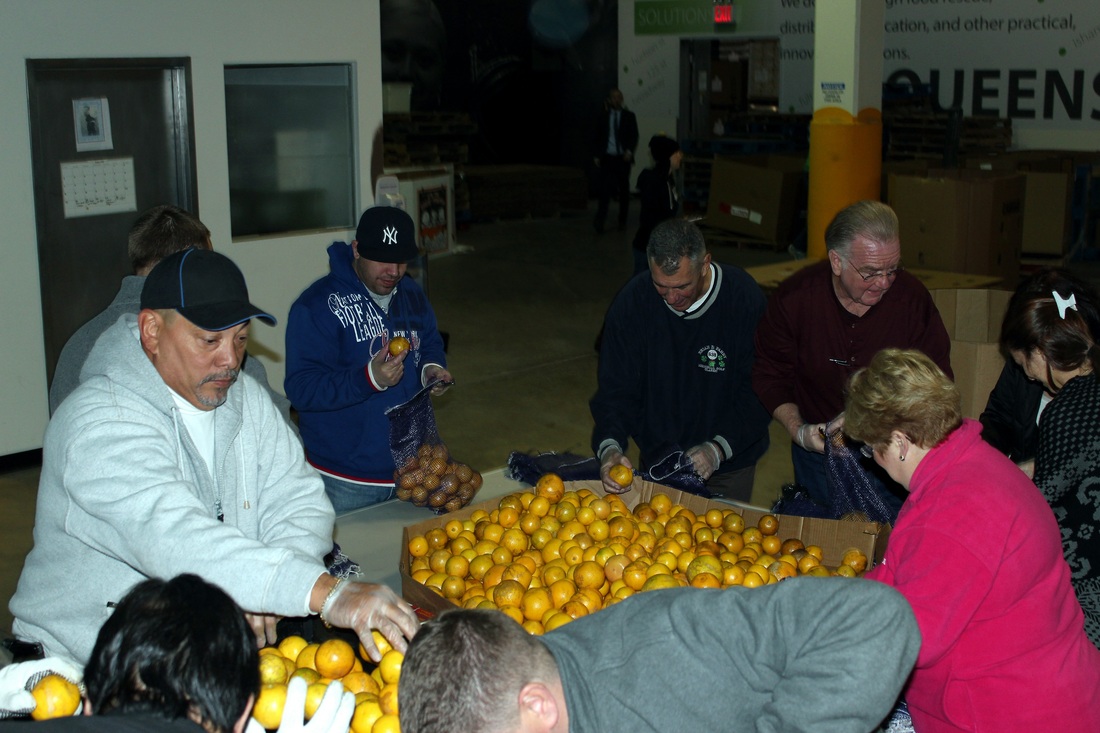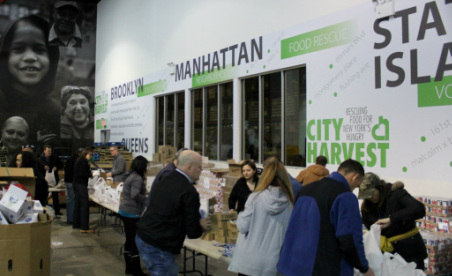|
I’ve never done much volunteer work because I was always busy.
Plus, my theory was, I was more valuable pecking away at the laptop for dollars than getting in somebody’s way. However, I have been in awe of a couple of new-generation doctors I know who volunteer in places like Haiti and Africa. And I saw my wife make a difference as a volunteer an orphanage in India. Having more time these days, I signed up for a few hours of labor with some new friends from The New York Times plant in College Point, Queens. Ever since the production and delivery part of the paper moved out of W. 43 St. in 1997, I have missed the bustle of the trucks and the workers on the sidewalks and elevators and in the cafeteria. Last week, Mike Connors, managing director of the Production Department, invited me to help pack food at the City Harvest warehouse right off the East River in Long Island City, Queens. Over 30 volunteers were given gloves and divided ourselves into two groups. One prepared bags of donated non-perishable food – bottled water, coconut water, canned tuna, dry cereal, beef jerky, packaged chocolate chip cookies, sardines, granola bars, tomato soup, beans, crushed tomatoes, pasta and anchovies. Anchovies! I was advised by Ernie Booth, an executive at the Times plant, that my vast skills were urgently needed at the other job – shuttling oranges from refrigerator-sized cardboard boxes into bags that held 15-20 oranges, large and small. I realized right away how much I enjoyed the teamwork – how individuals made room for each other, how they solved problems like getting oranges out of the bottom of the crates (tipping them and getting down on our knees, scooping with our forearms.) Later I tried bagging the oranges, chatting with new friends like Deirdre Deignan, an official from the Times plant, and Andy Gutterman, the executive director from HR/Human Relations, and other volunteers, about sports and past jobs. We worked at a fairly intense pace, with a sense of purpose. By late afternoon, most people had to go back to produce and deliver the next day’s Times. The City Harvest supervisors read off our output – 10,000 pounds of dry food, 7,000 pounds of oranges, eight and a half tons of food for dozens of eligible New York families with incomes under $60,000. week later, I look forward to spring when the NYT will do it again. I urge anybody not to wait as long as I did to volunteer a few hours, somewhere. For information, please see: http://www.cityharvest.org/
Ed Martin
12/4/2012 07:59:25 am
Hi George, Happy Holidays (of you choice or all). Peggy and I are sending a gift to City Harvest in recognition of your effort. Here on the West Coast of Florida friends might like to know of All Faiths Food Bank in Sarasota. Ciao.
Mike C
12/4/2012 10:34:28 am
George, as part of this very proud team, thanks so much for the piece here and most important for putthing the efforts of City Harvest onto the radar!! Its a most worthwhile organization and we had some fun that day as you made clear. We will be back on this playing field in April-2013!!
Janet Vecsey
12/4/2012 01:26:56 pm
Good job, big brother. Great cause. 12/5/2012 08:27:53 am
George
Brian Savin
12/10/2012 01:46:34 pm
NYC has a caring infrastructure of organizations and young people with lots of energy (and old folks with less energy but lots of care). I never understood all the connections between organizations. When I read this post, I became curious about City Harvest and Food Bank. I know them both, but not how they relate. A member of our family works for the City. I put the question to her mother. I got the following reply: 8/24/2013 02:42:08 am
We opted in for a couple of hours involving labor along with a number of fresh buddies in the New york Occasions place inside College or university Level, A queen. Comments are closed.
|
Categories
All
|











